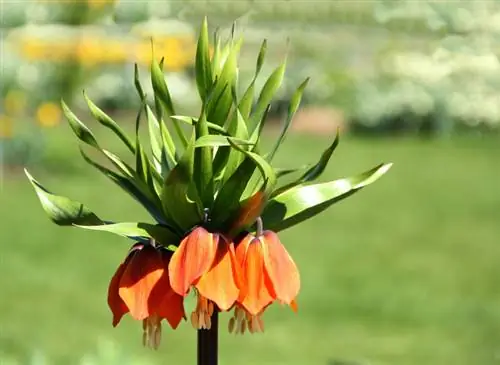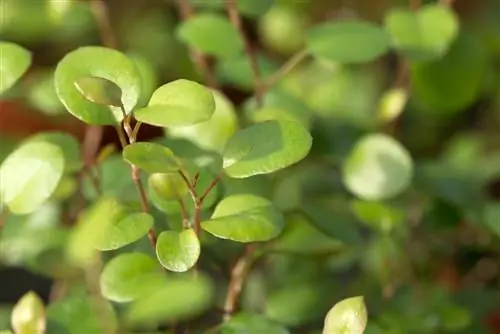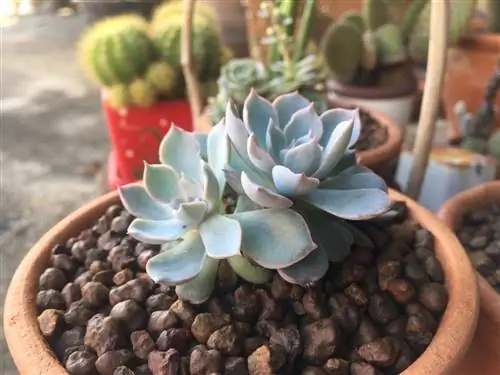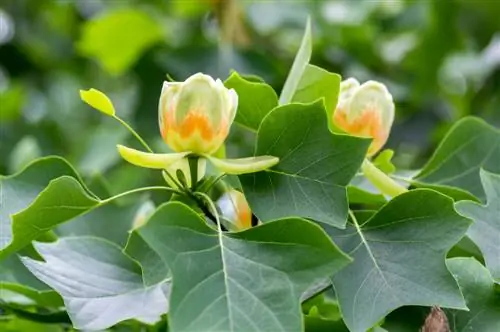- Author admin [email protected].
- Public 2024-01-05 20:48.
- Last modified 2025-06-01 06:02.
Bromeliads are among the most popular houseplants ever - because they require little care and offer an attractive leaf structure and often very colorful, spectacular flower formations that add an exotic accent to the room.
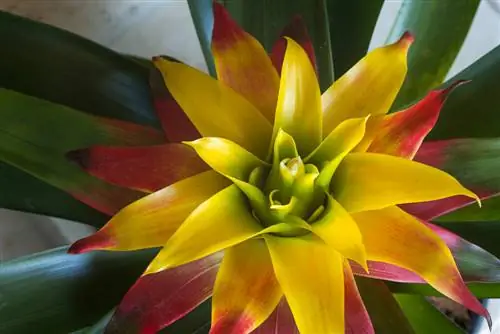
What are bromeliads and how do you care for them?
Bromeliads are exotic houseplants from South and Central America with attractive leaf structures and colorful flowers. They prefer bright, warm locations with high humidity and require little fertilizer. Bromeliads can grow epiphytically or terrestrially and can be propagated via Kindel.
Origin
Bromeliads not only look exotic, they are exotic: their native area is the so-called Neotropics, which extends primarily across South and Central America, but also across the West Indies. In terms of climate, their original habitats are very different from those in our latitudes - namely tropically warm, humid and not subject to four seasons. Nevertheless, some of the very numerous bromeliad species can be cultivated very well as ornamental plants in the room - at normal living temperatures in heated rooms they can thrive without any problems.
The bromeliads are named after the Swedish doctor Olaf Bromel. Incidentally, the first bromeliad came to Europe with the famous explorer Christopher Columbus - in the shape of a pineapple, which is probably the best-known type of bromeliad because of its fruit. Because of this, the plant family is also called the pineapple family.
To remember:
- Origin of bromeliads in South and Central America
- some species can be easily cultivated indoors
- first bromeliad species - pineapple - reached Europe through Columnus
Growth
The vast majority of bromeliads are evergreen perennials. The strong rosette structure with wide, tapering, upright leaves is typical of its appearance. In some species, rainwater collects in the funnel-like center of the leaf rosette. Many species are xerophytic, meaning they can reduce their evaporation through various mechanisms.
The Bromeliceae are also characterized by their epiphytic growth - they belong to the so-called epiphytes, like orchids. In nature they grow without roots, primarily on trees or rocks. When grown indoors, they are only kept in the pot for stabilization purposes.
The most important things at a glance:
- Bromeliads are mostly evergreen perennials
- have compressed shoot axis with leaf rosette
- Most species belong to the epiphytes, the rootless epiphytes
leaves
The leaves of bromeliads not only form a characteristic appearance feature - they are also essential nutrient channels for many species. As epiphytes, they ultimately cannot cover their nutrient needs through roots. Instead, they get nutrients and moisture directly from the air via absorbent scales and shed hairs on the tops of the leaves. Light hair helps reduce evaporation and protects against sunburn.
Bloom
Many people keep a bromeliad in their room or office because of the spectacular and colorful flowers. But what is usually so impressive is not the actual flower - in most ornamental species it is rather small and inconspicuous. However, it is surrounded by large bracts, which often appear in magnificent colors and last much longer than the actual flowers.
For most types of bromeliads, the formation of flowers is a very strenuous and therefore only a one-off event that results in the death of the leaf rosette or, in the case of the giant bromeliad, even the end of its life.read more
Which location is suitable?
The small selection from the huge range of Bromeliceae species that we keep as houseplants originally come from the tropical rainforests of South America. The species that come from airier, cooler mountain regions are generally of little relevance to our concerns.
It goes without saying that you should give an ornamental bromeliad - Guzmanias are particularly popular and widespread - a location with conditions that are as tropical as possible. It should therefore be bright, consistently warm and as humid as possible. It's best to place it in a window that lets in a lot of light but not full sunlight all the time.
The ambient temperature preferred by bromeliads practically corresponds to a room temperature of around 20°C, which many people find pleasantly warm. Of course it can get warmer, but the thermometer shouldn't drop below 18°C.
The most important location conditions for ornamental bromeliads:
- bright, but not full sun
- as high humidity as possible
- warm all year round, around 20°C and warmer
In summer you can also put most types of ornamental bromeliads outside. But again, make sure that it doesn't get any intense direct sun. In addition, putting it outside is usually only possible in phases - because on nights with temperatures below 15°C the bromeliad freezes too much so you have to bring it back inside.read more
What soil does the plant need?
As I said - as rootless epiphytes, most types of bromeliads don't actually need a pot with a soil substrate. In any case, you can't feed them that way. You can therefore plant the actually rootless varieties in a loose substrate made of bark and peat moss like an orchid. The bromeliad just needs to hold on to this - until it has achieved this, you can initially help it with a little wire. The epiphytic bromeliads can even be cultivated on stones.
In a pot with soil, you may be able to handle the bromeliad a little better and integrate it structurally and visually more homogeneously into your houseplant kingdom. In the case of terrestrially growing, root-forming varieties, which also exist among the ornamental species, a soil substrate is necessary, in contrast to epiphytic bromeliads. It should be lime-free and permeable. You can also use special orchid soil, optionally mixed with normal potting soil.
The substrate design at a glance:
- for epiphytic species: culture possible in a bark-peat moss substrate or on stones
- for terrestrial species: lime-free soil substrate made from orchid soil and potting soil
Watering bromeliads
When it comes to watering, a distinction must also be made between the rootless and terrestrial types of bromeliads. The terrestrial ones are, of course, watered quite normally with a watering can and supplied with moisture via the soil substrate. You should always keep the substrate moist - don't forget that the bromeliad is a rainforest plant. It is also important to always keep the rosette funnel filled with water, especially in summer. When watering, it is best to use water that is as lime-free as possible and at room temperature.
In winter, however, the bromeliad may only be watered a little due to the reduced light available. You then only fill the leaf funnel very sparingly.
Epiphytic bromeliads that you have only placed in a dry base to hold on to, do not use the watering can, but rather use a disperser to apply their water directly to the leaves, which absorb it with their suction scales. The water quality criteria mentioned above also apply here.
By the way, you shouldn't refrain from spraying the terrestrial bromeliads either - of course they also like the occasional gentle tropical rain!
To remember:
- keep terrestrial bromeliads consistently moist
- Always keep the central funnel in the leaf rosette filled with water
- Use low-lime, room temperature water
- epiphytic bromeliads only spray
read more
Fertilize bromeliads properly
Bromeliads don't need much fertilization. During the main summer vegetation phase, you can add a little liquid fertilizer to the irrigation water once a week.
Cut bromeliad correctly
The topic of cutting is also rather subtle when it comes to indoor bromeliads. Their compact, even rosette growth makes formal trimming unnecessary.
The question remains about the possible rejuvenating, refreshing removal of dead plant parts. Of course, the leaves of the bromeliad also come to an end. If they wilt and dry out, you should carefully pluck them out or let them fall off on their own. The fiber structure of the bromeliad leaves does not tolerate cuts particularly well.read more
Dried up
You should of course avoid dried leaves of your indoor bromeliad by diligently keeping them moist. It is normal for the beautiful bracts to dry out at some point after the flower has faded and does not need to be “treated”. Simply continue watering as normal - this promotes the formation of children, which the bromeliad is ready for after flowering.
Propagate bromeliads
This brings us straight to the topic of reproduction. Bromeliads mostly reproduce themselves via children. These grow as side shoots - so you only need to cut them off as soon as they have matured with the leaf rosette and roots. Then the side shoot is usually about half the size of the mother plant. However, you should be very careful when cutting. It is best to use a freshly sharpened knife and disinfect it with high-percentage alcohol before cutting.
The child is placed in a low-lime, loose substrate and is best covered with foil. This way you can offer it an evenly moist, protected microclimate to root.
Share
Dividing in the classic sense, i.e. cutting through the root ball, is of course out of place with bromeliads. They can only be divided in the sense of separating the children from the mother plant for propagation purposes.read more
Is bromeliad poisonous?
When it comes to exotic ornamental plants, you often don't know exactly whether they are poisonous - to people or to pets. This is certainly the case with some magnificent-looking varieties. However, bromeliads are generally not poisonous. So much for the good news. However, the leaves of some ornamental bromeliads contain skin-irritating substances such as calcium oxalates and the enzyme bromelin. They are not toxic, but small children and pets should not necessarily consume bromeliad leaves.read more
Food
Due to their typically pineapple-like growth, you may wonder whether other types of bromeliads besides pineapples are edible in any way. However, only the fruits of the pineapple are actually edible. There are a few different varieties, which the average consumer in this country doesn't know much about - because only the Smooth Cayenne variety is marketed commercially and worldwide. Varieties from other groups such as the Queen or Pernambuco groups are grown in South America primarily for fresh consumption.
Tip
As with many ornamental plants from the tropics, you can give a bromeliad its preferred warm, humid climate simply by placing it in the bathroom. This means you don't have to constantly monitor that the humidity is sufficiently high.
Varieties
Guzmania
The Guzmanias are probably the most popular and widespread group of ornamental bromeliads cultivated in this country. They can be found on many window sills, where they conjure up exotic splashes of color with their bright bracts in red, orange, pink or yellow. The flowering period is in winter, roughly between December and February - however, the joy of blossoming is not only unique, but unfortunately also short-lived. Overall, a Guzmania can reach a height of 30 to 60 cm. Within the Guzmanien genus there are up to 200 species.
Air Carnations
With around 550 species, the aerial carnations, botanically Tillandsia, form the most diverse genus of the Bromeliceae. They are of the epiphytic variety, so they can be cultivated in a bark-peat moss substrate or on stones and only need to be sprayed with water. There are also isolated species that grow terrestrially.
Their inflorescences offer a very original and eye-catching sight with their bizarre structures and shapes, usually in reddish to pink tones. The many subspecies can reach very different sizes. Some only grow to a height of 30 cm, others produce leaves that are up to 50 cm long.
Tillandsias are specifically suitable for temporary stays outdoors.
Flaming Sword
This bromeliad genus, botanically called Vriesea, gets its pathetic name from its sword-shaped, curved, shiny inflorescences with bracts in bright orange to scarlet red, which appear individually or in groups. Flowering time can be at different times of the year depending on environmental conditions. Depending on the variety, the leaves of the Vriesea can be up to 75 cm long, such as the Vriesea hieroglychipca. The flower stem is usually not significantly smaller. The leaves of the Flaming Sword can also be very decorative with delicate ribbon structures in creamy to reddish tones.
Nest rosette
The nest rosettes, botanically Nidularium, are characterized by a nest-like arrangement of the leaf rosette. Its leathery, soft leaves are prickly-toothed and covered in a natural sheen. The inflorescences delight with the colorful bracts in reddish, yellow or orange tones that appear well before the flowering period. The flower itself produces the nest rosette between June and September. Depending on the species, a height of up to 30 cm can be achieved.
Lance rosette
The name of the lance rosette, botanically Aechmea, is also significant - it describes the tall, up to 30 cm long inflorescences, which are decorated with brightly colored bracts for months. The small flowers are blue in color and only last for a very short time. Depending on the subspecies, lance rosettes reach a height of between 35 and 50 cm. The strong leaves are also up to 50 cm long and up to 10 cm wide. They are armed with spines on the edge and at the tip of the leaf. Aechmeas, like tillandsias, can be left outside for a while during warm summer periods with relative ease.
ornamental pineapple
Not all types of pineapple are grown with the sweet, aromatic fruits in mind - there are also some ornamental types that look very pretty on the windowsill. Some species are decorated with attractive color accents on the otherwise gray-green leaves and thus offer a great, exotic sight. Although the fruits of these varieties are not edible, they are decorative in their own way with their dark pink color. However, you need some space for an ornamental pineapple: with a height of around one meter, it can reach a width of up to two meters.


